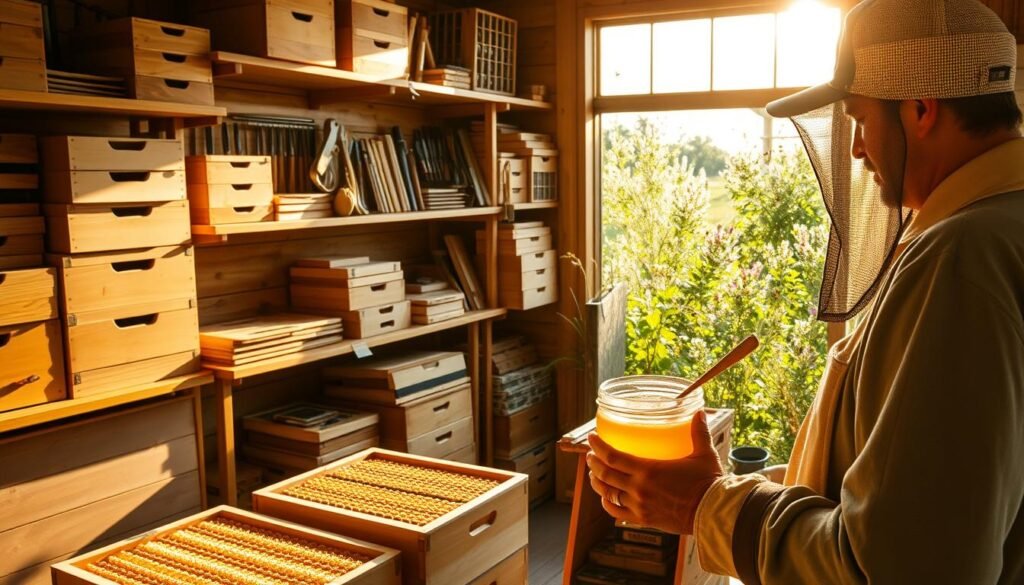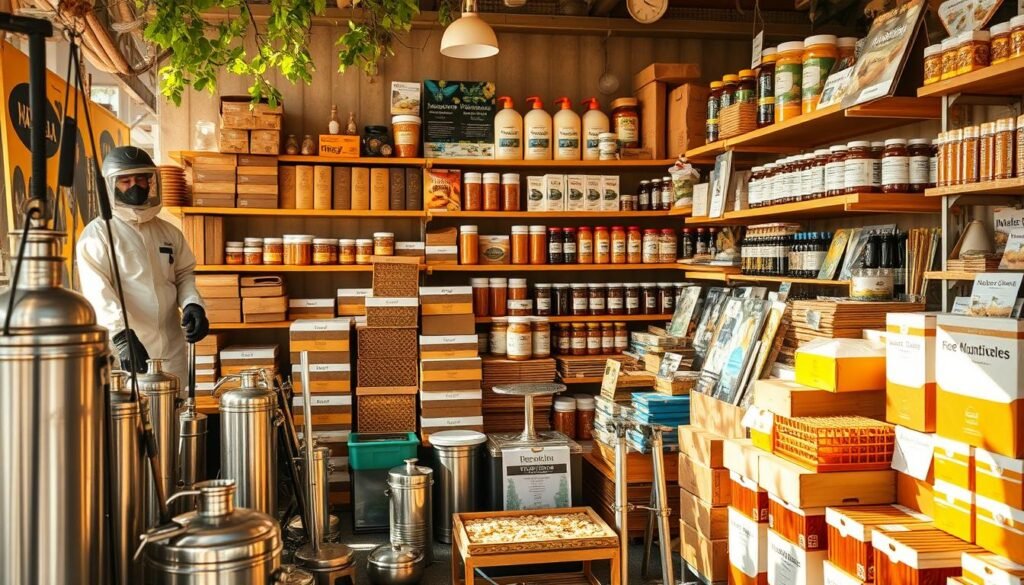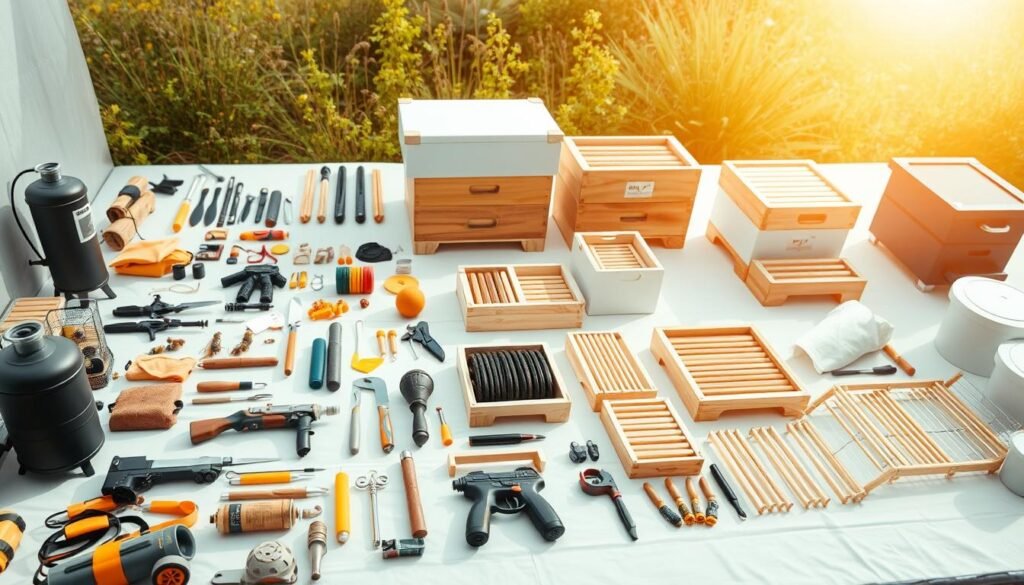Starting your journey in apiculture? The right tools aren’t just helpful – they’re essential. From protective wear to hive tools, every item plays a role in keeping both you and your colony safe. Australia’s unique climate and flora demand gear that’s built to handle harsh sunlight, variable temperatures, and busy hives.
Local apiarists know that cutting corners with subpar tools leads to frustration. Quality materials last longer, perform better, and ultimately save money. Whether you’re inspecting a backyard hive or managing multiple colonies, durable gear adapts to our conditions – from tropical north to temperate south.
Modern innovations have transformed traditional methods. Lightweight suits with improved ventilation, ergonomic hive tools, and precision smokers now dominate the market. These advancements make hive checks less intrusive and more efficient, benefiting both keeper and bees.
Key Takeaways
- Proper tools enhance safety during hive inspections
- Climate-adaptive gear suits Australia’s diverse regions
- Durable materials reduce long-term costs
- Local suppliers understand regional needs
- Tech upgrades improve hive management efficiency
Overview of Beekeeping Equipment in Australia
Australia’s apiculture landscape thrives on specialised products designed for its rugged conditions. Suppliers now offer supplies ranging from classic cedar hive boxes to UV-resistant polymer frames, catering to both hobbyists and commercial operators. Distribution networks stretch from coastal cities to remote outback towns, with many providers offering doorstep delivery for rural clients.
Local manufacturers dominate 63% of the market, creating gear that meets strict biosecurity standards. These products often outperform imports through:
- Reinforced stitching in protective suits for thorny bush conditions
- Hive tools with anti-rust coatings for humid northern climates
- Standardised sizing compatible with Australian hive configurations
Seasonal shifts dramatically influence availability. Winter sees spikes in honey extractor sales, while spring drives demand for swarm-catching kits. Smart buyers plan purchases during autumn clearance sales when suppliers discount surplus stock.
The push for sustainable practices has sparked innovations like biodegradable hive wraps and pheromone-based pest traps. As one Queensland apiarist notes: “Local makers adapt faster to our varroa mite threats than overseas companies”. This responsiveness gives Australian-made supplies a critical edge in maintaining healthy colonies.
Choosing the Right Beekeeping Setup
Australia’s vast landscapes demand tailored solutions for maintaining healthy colonies. Your location’s specific challenges – from cyclonic winds in the north to arid zones in the Red Centre – directly shape what gear works best.
Evaluating Your Hive Environment
Coastal keepers face salt corrosion and high humidity. Inland apiarists battle temperature swings exceeding 40°C daily. Consider these factors:
- Bushfire-prone regions need fire-resistant hive stands
- Tropical areas require ventilation-focused hive designs
- Urban settings demand compact, neighbor-friendly setups
A Victorian beekeeper notes: “Our summer gear differs completely from Tasmania’s winter kits – it’s not one-size-fits-all”.
Selecting Gear to Fit Your Needs
Langstroth hives dominate commercial operations with their modular design. Top-bar systems suit hobbyists wanting simplicity. Warre hives attract naturalists prioritizing minimal intervention.
Ask yourself:
- How many hours weekly can I dedicate?
- Do I plan to expand beyond 5 hives?
- What’s my main goal – pollination, honey, or conservation?
Scalability matters. Starting with two movable-frame hives allows easier expansion than fixed-comb systems. Quality stainless steel tools outlast cheaper alternatives, saving replacement costs.
Essential Tools for New Beekeepers
First-time apiarists need six core instruments to manage colonies confidently. These items form your operational foundation, transforming daunting tasks into routine checks. Proper selection directly impacts both safety and hive health.
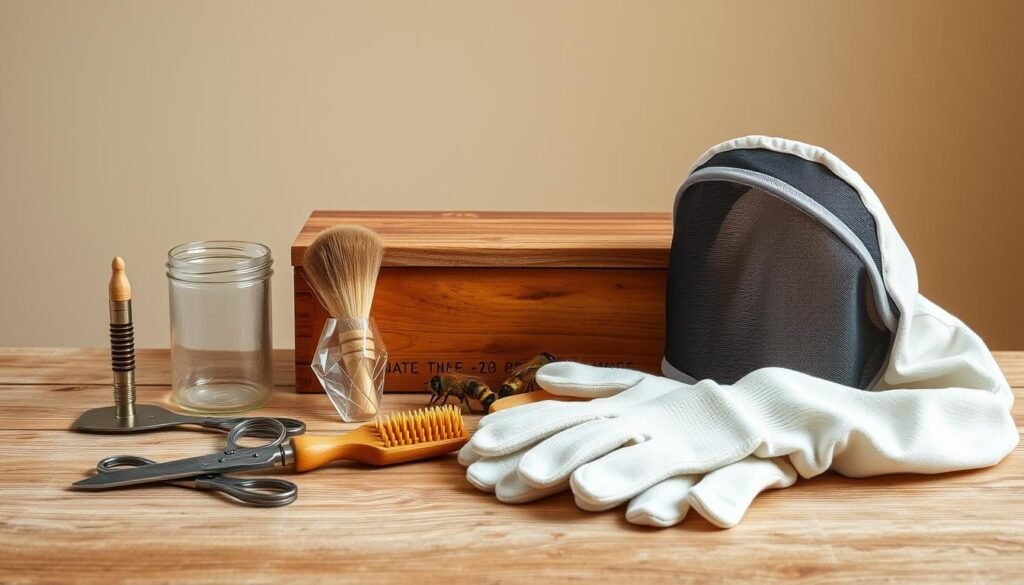
Must-Have Gear for Hive Maintenance
Start with these non-negotiable items:
| Tool | Purpose | Key Feature |
|---|---|---|
| Hive tool | Prying frames apart | Stainless steel edge |
| Smoker | Calming bees | Heat-resistant nozzle |
| Jacket & veil | Upper-body protection | Mesh ventilation |
| Gloves | Hand safety | Goatskin flexibility |
Benefits of Starting with Quality Tools
Durable gear withstands Australia’s extremes. Cheap alternatives crack under UV exposure or warp in humidity. A NSW beekeeper shares: “My first smoker lasted 12 years – it’s still my backup.”
Quality items reduce replacement costs. They also improve precision during inspections, helping spot queen cells or pests faster.
Understanding Safety Measures
Always wear sealed clothing – gaps invite stings. Keep antihistamines nearby and establish an exit route before opening hives. Novices should practice lighting smokers away from colonies to master airflow control.
Regularly inspect gear for wear. Frayed veils or stiff gloves compromise protection. Store tools dry to prevent rust, especially in coastal areas.
Detailed Look at the Hive Tool
Every colony manager knows that sticky propolis transforms hive components into a puzzle. This resinous glue demands a specialised implement to separate frames and maintain order. The right choice here becomes an extension of your hands during inspections.
Features of a Quality Hive Tool
Premium versions use high-carbon steel that resists bending. Look for:
- Tempered edges that stay sharp through heavy use
- Forged construction without weak weld points
- Textured grips that won’t slip in sweaty palms
Australia’s climate tests materials harshly. Coastal humidity rusts cheap metals within months. A Tasmanian apiarist confirms: “My stainless steel tool outlasted three seasons of salt spray.”
| Design | Best Use | Material | Key Benefit |
|---|---|---|---|
| Traditional Straight | Basic prying | Mild steel | Affordable |
| Ergonomic Grip | Frequent inspections | Stainless steel | Reduces hand fatigue |
| Multi-Tool | Comb cutting | Carbon alloy | All-in-one function |
Practical Tips for Everyday Use
Insert the flat end between frames at a 45° angle. Twist gently to break propolis bonds without splintering wood. Wipe the blade after each use with a damp cloth.
Store the tool dry to prevent corrosion. Sharpen the edge monthly using a mill file – maintain the original bevel angle. Seasoned keepers recommend carrying two tools: one for scraping, another for precise work.
Proper technique protects both colony and keeper. A smooth motion minimises vibrations that disturb bees. Regular maintenance ensures your primary implement stays reliable through countless hive checks.
The Importance of Smoker and Protective Gear
Managing colonies safely requires mastering two critical elements: smoke application and physical barriers. These components work synergistically to create controlled inspection conditions while respecting honeybee behaviour.
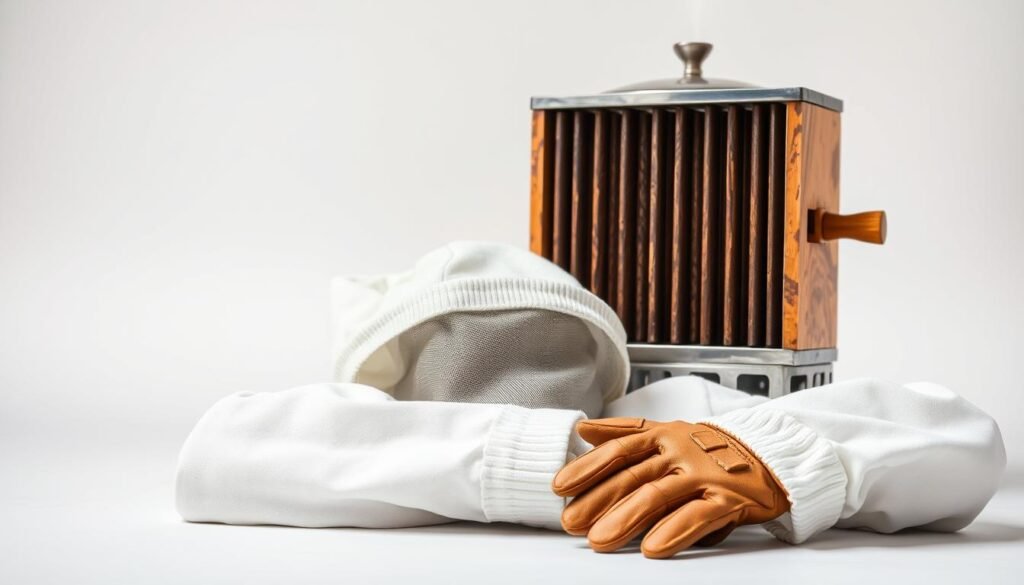
Science Behind Smoke Calming Effects
When smoke enters the hive, honeybees instinctively gorge on honey. This survival response prepares them for potential relocation during wildfires. Full stomachs physically restrict their ability to arch for stinging.
Smoke also scrambles communication. Guard bees release alarm pheromones when threatened – thin plumes mask these chemical signals. Cool, white smoke proves most effective, unlike harsh black smoke that agitates colonies.
Optimising Protective Wear
Australian conditions demand breathable suits with reinforced stitching. Look for:
- Mesh panels under arms for airflow
- Elasticated cuffs with double closures
- Detachable veils preventing facial heat buildup
Gloves require flexibility without compromising protection. Goatskin options offer dexterity for handling frames while resisting sting penetration. A Brisbane apiarist notes: “Lightweight suits with ventilation flaps let me work longer in humid weather.”
Proper smoker maintenance ensures reliable performance. The American Smoker’s stainless steel construction resists corrosion, while its grated base improves airflow for sustained burning. Use eucalyptus leaves or commercial pellets – both produce clean smoke ideal for Australian hives.
Comprehensive Beekeeping Starter Kits
First-time colony managers can streamline their setup with bundled solutions. These packages combine 12-15 essential items, from smokers to frame grips, eliminating the guesswork of separate purchases. Suppliers design them specifically for Australia’s conditions, ensuring components work seamlessly together.
Bundle Benefits for Beginners
Starter kits typically include:
- UV-resistant veil and jacket sets
- Stainless steel hive tool with ergonomic grip
- Fuel-efficient smoker with protective cage
- Pre-assembled frames compatible with local hive types
New South Wales apiarist Mia Roberts explains: “My kit’s instructional videos saved hours of YouTube scrambling during swarm season.” Many suppliers add QR codes linking to regional-specific tutorials and pest alerts.
Cost and Value Considerations
Bundled purchases save 25-40% compared to buying items individually. Compare these typical prices:
| Item | Solo Cost | Kit Cost |
|---|---|---|
| Protective Suit | $189 | $329 |
| Hive Tool | $45 | |
| Smoker | $79 |
Quality remains consistent – kits use the same materials as professional-grade tools. Manufacturers often include warranty extensions for bundled purchases. For those managing tight budgets, these packages deliver lasting value while establishing proper hive-handling habits from day one.
Top Quality Beekeeping Equipment Providers in Australia
Selecting reliable partners makes all the difference when maintaining productive colonies. Australian suppliers combine local expertise with robust product testing, delivering solutions adapted to regional challenges from coastal humidity to outback dust storms.
Local Suppliers You Can Trust
Leading companies like Bee2Bee and Honeyflow operate nationwide warehouses with same-day dispatch for urgent orders. Their offerings include:
- Biosecurity-compliant gear meeting state regulations
- Custom hive configurations for native stingless bee species
- Real-time stock updates via mobile apps
| Supplier | Specialisation | Delivery Coverage | Support Services |
|---|---|---|---|
| Bee2Bee | Commercial operations | Next-day metro areas | 24/7 apiary hotline |
| Honeyflow | Urban setups | 3-day rural | Free hive design consultations |
| AussieBee Co. | Organic products | 5-day national | Beekeeper mentorship programs |
Value-Added Services and Support
Premium providers invest in customer success beyond transactions. Bee2Bee’s colony health webinars help new apiarists identify mite outbreaks early. Honeyflow offers equipment servicing plans with discounted replacement parts.
Regional distribution hubs ensure critical supplies reach remote areas within 48 hours. As Queensland apiarist Liam Carter notes: “Local knowledge matters when choosing gear that stands up to our cyclonic rains.”
Leading companies actively sponsor industry events like the National Honey Show, fostering skill development across the sector. These partnerships ensure suppliers stay attuned to evolving needs while maintaining high service standards.
Exploring Key Accessories for Beekeepers
Beyond core instruments, Australian apiarists rely on specialised accessories to streamline operations. These add-ons address unique challenges while boosting productivity across seasons. From delicate comb work to swarm control, the right extras make complex tasks manageable.
Essential Add-Ons for Hive Management
A soft-bristle bee brush proves invaluable during honey harvests. Gentle sweeps clear frames without crushing workers, though use sparingly – agitated bees may attack the bristles. Pair it with queen excluders for precise brood chamber management.
Tech upgrades bring new precision to hive checks. Digital scales track honey yields in real time, while Bluetooth thermometers alert to temperature spikes. Some local suppliers now offer app-connected cameras that monitor entrance activity 24/7.
Seasonal solutions adapt to Australia’s extremes. Summer demands ventilated hive wraps to prevent overheating, while winter requires mouse guards for protection. Always match accessories to your region’s specific threats – coastal areas benefit from rust-proof components.
Pro tip: Clean brushes with cool water after swarm removal jobs. Residual pheromones could trigger defensive behaviour during future inspections.


